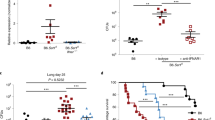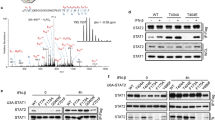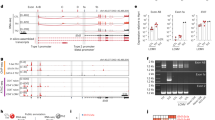Abstract
The use of murine systems to model pathogen-induced human diseases presumes that general immune mechanisms between these species are conserved. One important immunoregulatory mechanism involves linkage of innate and adaptive immunity to direct the development of T helper subsets, for example toward subset 1 (TH1) development through STAT4 activation. In analyzing type I interferon signaling, we uncovered a difference between murine and human cells which may affect how these two species control linkage between innate and adaptive immunity. We show that in humans, type I interferons induce TH1 development and can activate STAT4 by recruitment to the IFN-α receptor complex specifically via the carboxy-terminus of STAT2. However, the mouse Stat2 gene harbors a minisatellite insertion that has altered the carboxy-terminus and selectively disrupted its capacity to activate STAT4, but not other STATs. This defect in murine Stat2 suggests that the signals leading to STAT4 activation and TH1 development in CD4+ T cells are different between mice and humans.
This is a preview of subscription content, access via your institution
Access options
Subscribe to this journal
Receive 12 print issues and online access
$209.00 per year
only $17.42 per issue
Buy this article
- Purchase on Springer Link
- Instant access to full article PDF
Prices may be subject to local taxes which are calculated during checkout






Similar content being viewed by others
References
Abbas, A. K., Murphy, K. M. & Sher, A. Functional diversity of helper T lymphocytes. Nature 383, 787–793 (1996).
Trinchieri, G. Interleukin-12: a proinflammatory cytokine with immunoregulatory functions that bridge innate resistance and antigen-specific adaptive immunity. Annu. Rev. Immunol. 13, 251–276 (1995).
Hsieh, C.-S et al. Development of Th1 CD4+ T cells through IL-12 produced by Listeria-induced macrophages. Science 260, 547–549 (1993).
Jacobson, N. G. et al. Interleukin 12 signaling in T helper type 1 (Th1) cells involves tyrosine phosphorylation of signal transducer and activator of transcription (Stat)3 and Stat4. J. Exp. Med. 181, 1755–1762 (1995).
Unanue, E. R. Studies in listeriosis show the strong symbiosis between the innate cellular system and the T-cell response. Immunol. Rev. 158, 11–25 (1997).
Bacon, C. M. et al. Interleukin 12 induces tyrosine phosphorylation and activation of STAT4 in human lymphocytes. Proc. Natl Acad. Sci. USA 92, 7307–7311 (1995).
Kaplan, M. H., Sun, Y.-L, Hoey, T. & Grusby, M. J. Impaired IL-12 responses and enhanced development of Th2 cells in Stat4-deficient mice. Nature 382, 174–177 (1996).
Thierfelder, W. E. et al. Requirement for Stat4 in interleukin-12-mediated responses of natural killer and T cells. Nature 382, 171–174 (1996).
Manetti, R. et al. Interleukin 12 induces stable priming for interferon γ (IFN-γ) production during differentiation of human T helper (Th) cells and transient IFN-γ production in established Th2 cell clones. J. Exp. Med. 179, 1273–1283 (1994).
de Jong, R. et al. Severe mycobacterial and Salmonella infections in interleukin-12 receptor-deficient patients. Science 280, 1435–1438 (1998).
Altare, R. et al. Impairment of mycobacterial immunity in human interleukin-12 receptor deficiency. Science 280, 1432–1435 (1998).
Wenner, C. A., Güler, M. L., Macatonia, S. E., O'Garra, A. & Murphy, K. M. Roles of IFN-γ and IFN-γ in IL-12-induced T helper cell-1 development. J. Immunol. 156, 1442–1447 (1996).
Rogge, L. et al. Selective expression of an interleukin-12 receptor component by human T helper 1 cells. J. Exp. Med. 185, 825–831 (1997).
Rogge, L. et al. The role of Stat4 in species-specific regulation of Th cell development by type I IFNs. J. Immunol. 161, 6567–6574 (1998).
Farrar, J. D., Smith, J. D., Murphy, T. L. & Murphy, K. M. Recruitment of Stat4 to the human IFN-α/β receptor requires activated Stat2. J. Biol. Chem. 275, 2693–2697 (2000).
Parronchi, P. et al. IL-4 and IFN (α and γ) exert opposite regulatory effects on the development of cytolytic potential by Th1 or Th2 human T cell clones. J. Immunol. 149, 2977–2983 (1992).
Brinkmann, V., Geiger, T., Alkan, S. & Heusser, C. H. Interferon α increases the frequency of interferon γ-producing human CD4+ T cells. J. Exp. Med. 178, 1655–1663 (1993).
Cho, S. et al. Activation of STAT4 by IL-12 and IFN-α. Evidence for the involvement of ligand-induced tyrosine and serine phosphorylation. J. Immunol. 157, 4781–4789 (1996).
Naeger, L. K., McKinney, J., Salvekar, A. & Hoey, T. Identification of a STAT4 binding site in the interleukin-12 receptor required for signaling. J. Biol. Chem. 274, 1875–1878 (1999).
Stark, G. R., Kerr, I. M., Williams, B. R., Silverman, R. H. & Schreiber, R. D. How cells respond to interferons. Annu. Rev. Biochem. 67, 227–264 (1998).
Li, X, Leung, S., Kerr, I. M. & Stark, G. R. Functional subdomains of STAT2 required for preassociation with the alpha interferon receptor and for signaling. Mol. Cell. Biol. 17, 2048–2056 (1997).
Yan, H. et al. Phosphorylated interferon-α receptor 1 subunit (IFN-αR1) acts as a docking site for the latent form of the 113 kDa STAT2 protein. EMBO J. 15, 1064–1074 (1996).
Qureshi, S. A., Leung, S., Kerr, I. M., Stark, G. R. & Darnell, J. E. Function of Stat2 protein in transcriptional activation by alpha interferon. Mol. Cell. Biol. 16, 288–293 (1996).
Leung, S., Qureshi, S. A., Kerr, I. M., Darnell, J. E. & Stark, G. R. Role of STAT2 in the α interferon signaling pathwaya. Mol. Cell. Biol. 15, 1312–1317 (1995).
Yang, C.-H et al. Direct association of STAT3 with the IFN-αR-1 chain of the human type I interferon receptor. J. Biol. Chem. 271, 8057–8061 (1996).
Pfeffer, L. M. et al. STAT3 as an adapter to couple phosphatidylinositol 3-kinase to the IFN-αR1 chain of the type I interferon receptor. Science 276, 1418–1420 (1997).
McKendry, R., John, J., Flavell, R. A., Kerr, I. M. & Stark, G. R. High-frequency mutagenesis of human cells and characterization of a mutant unresponsive to both α and γ interferons. Proc. Natl Acad. Sci. USA 88, 11455–11459 (1991).
Yan, R., Qureshi, S. A., Zhong, Z., Wen, Z. & Darnell, J. E. The genomic structure of the STAT genes: multiple exons in coincident sites in Stat1 and Stat2. Nucleic Acids Res. 23, 459–463 (1995).
Paulson, M et al. Stat protein transactivation domains recruit p300/CBP through widely divergent sequences. J. Biol. Chem. 274, 25343–25349 (1999).
Park, C., Lecomte, M. J. & Schindler, C. Murine Stat2 is uncharacteristically divergent. Nucleic Acids Res. 27, 4191–4199 (1999).
Poy, F. et al. Crystal structures of the XLP protein SAP reveal a class of SH2 domains with extended, phosphotyrosine-independent sequence recognition. Mol.Cell 4, 555–561 (1999).
Sayos, J. et al. The X-linked lymphoproliferative-disease gene product SAP regulates signals induced through the co-receptor SLAM. Nature 395, 462–469 (1998).
Mayer, B. J., Jackson, P. K., Van Etten, R. A. & Baltimore, D. Point mutations in the abl SH2 domain coordinately impair phosphotyrosine binding in vitro and transforming activity in vivo. Mol. Cell Biol. 12, 609–618 (1992).
Kagi, D., Ledermann, B., Burki, K., Zinkernagel, R. M. & Hengartner, H. Molecular mechanisms of lymphocyte-mediated cytotoxicity and their role in immunological protection and pathogenesis in vivo. Annu. Rev. Immunol. 14, 207–232 (1996).
Schmid, D. S. The human MHC-restricted cellular response to herpes simplex virus type 1 is mediated by CD4+, CD8- T cells and is restricted to the DR region of the MHC complex. J. Immunol. 140, 3610–3616 (1988).
Schmid, D. S. & Mawle, A. C. T cell responses to herpes simplex viruses in humans. Rev. Infect. Dis. 13 Suppl. 11, S946–S949 (1991).
Schmid, D. S. and Rouse, B. T. The role of T cell immunity in control of herpes simplex virus. Curr. Top. Microbiol. Immunol. 179, 57–74 (1992).
Jacobson, S., Sekaly, R. P., Jacobson, C. L., McFarland, H. F. & Long, E. O. HLA class II-restricted presentation of cytoplasmic measles virus antigens to cytotoxic T cells. J. Virol. 63, 1756–1762 (1989).
Jacobson, S. et al. Recognition of intracellular measles virus antigens by HLA class II restricted measles virus-specific cytotoxic T lymphocytes. Ann. NY Acad. Sci. 540, 352–353 (1988).
Carter, L. L. & Murphy, K. M. Lineage-specific requirement for signal transducer and activator of transcription (Stat)4 in Interferon γ production from CD4+ versus CD8+ T cells. J. Exp. Med. 189, 1355–1360 (1999).
Ranganath, S. H. et al. GATA-3-dependent enhancer activity in IL-4 gene regulation. J. Immunol. 161, 3822–3826 (1998).
Ouyang, W. et al. Inhibition of Th1 development mediated by GATA-3 through an IL-4-independent mechanism. Immunity 9, 745–755 (1998).
Needleman, S. B. & Wunsch, C. D. A general method applicable to the search for similarities in the amino acid sequence of two proteins. J. Mol. Biol. 48, 443–453 (1970).
Güler, M. L., Jacobson, N. G., Gubler, U. & Murphy, K. M. T cell genetic background determines maintenance of IL-12 signaling. Effects on BALB/c and B10.D2 T helper cell type 1 phenotype development. J. Immunol. 159, 1767–1774 (1997).
Acknowledgements
We thank Dominic Fenoglio for help with Cell Sorting and Alice Mui for a partial murine Stat2 cDNA. This work was supported by NIH grants AI34580, and HL56419. K.M.M. is an Associate Investigator of the Howard Hughes Medical Institute.
Author information
Authors and Affiliations
Corresponding author
Rights and permissions
About this article
Cite this article
Farrar, J., Smith, J., Murphy, T. et al. Selective loss of type I interferon-induced STAT4 activation caused by a minisatellite insertion in mouse Stat2. Nat Immunol 1, 65–69 (2000). https://doi.org/10.1038/76932
Received:
Accepted:
Issue Date:
DOI: https://doi.org/10.1038/76932
This article is cited by
-
HSV-1 0∆NLS vaccine elicits a robust B lymphocyte response and preserves vision without HSV-1 glycoprotein M or thymidine kinase recognition
Scientific Reports (2022)
-
Stat2 stability regulation: an intersection between immunity and carcinogenesis
Experimental & Molecular Medicine (2020)
-
Transcriptomics in lung tissue upon respiratory syncytial virus infection reveals aging as important modulator of immune activation and matrix maintenance
Scientific Reports (2018)
-
Mouse and human intestinal immunity: same ballpark, different players; different rules, same score
Mucosal Immunology (2011)
-
STAT2 hypomorphic mutant mice display impaired dendritic cell development and antiviral response
Journal of Biomedical Science (2009)



